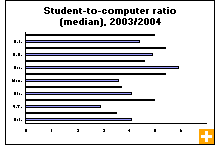Common menu bar links
Connected schools
Archived Content
Information identified as archived is provided for reference, research or recordkeeping purposes. It is not subject to the Government of Canada Web Standards and has not been altered or updated since it was archived. Please contact us to request a format other than those available.
With the information and communications technology (ICT) industry growing considerably since the end of the 1990s, Canadian schools have been equipped with the infrastructure needed to integrate ICT into teaching. In 2003/2004, most elementary and secondary schools had computers and were connected to the Internet. They generally had one computer for every five students. There were fewer students per computer in small schools compared with large schools, and in secondary schools compared with elementary schools.
A number of software applications have become generally available throughout most schools. In 2003/2004, 78% of school principals reported that word processing software was the application most often incorporated into teaching practices.
Nearly 61% of principals reported providing their students with frequent access to computers connected to the Internet during school times outside the hours of instruction (that is, at lunchtime or during breaks). Some 42% of schools often made computers available to students before or after school.
 The availability of computers does not necessarily mean that students and
teachers use them effectively or that the computer equipment is of good quality.
In 2003/2004, three out of four principals reported that most teachers had
the technical skills needed to use ICT in administrative tasks such as preparing
marks. However, slightly less than half felt that most of their teachers
had the qualifications to engage students in using ICT effectively. Half
of principals reported that ensuring that computers and peripherals are up
to date was a challenge to using ICT in their school.
The availability of computers does not necessarily mean that students and
teachers use them effectively or that the computer equipment is of good quality.
In 2003/2004, three out of four principals reported that most teachers had
the technical skills needed to use ICT in administrative tasks such as preparing
marks. However, slightly less than half felt that most of their teachers
had the qualifications to engage students in using ICT effectively. Half
of principals reported that ensuring that computers and peripherals are up
to date was a challenge to using ICT in their school.
Today, students can receive instruction online as an alternative to traditional learning, which was almost inconceivable a decade ago. In 2003/2004, more than one-third of secondary schools had students taking online courses, compared with only 3% of elementary schools.


